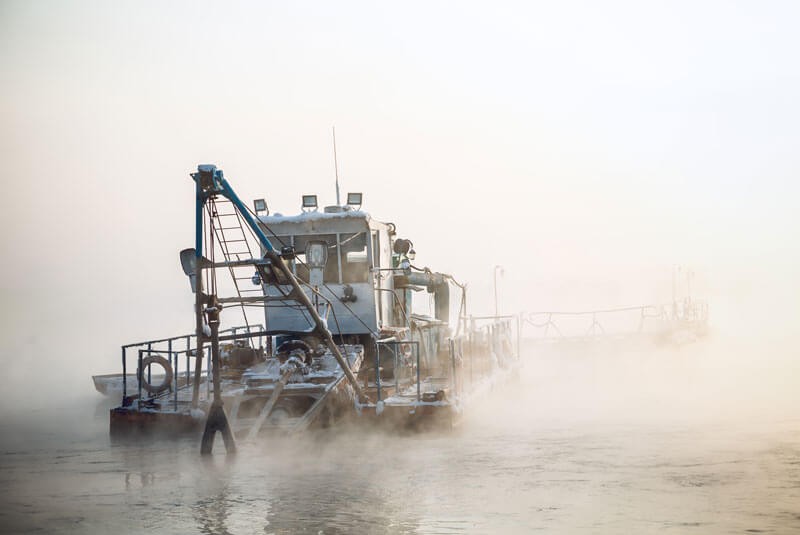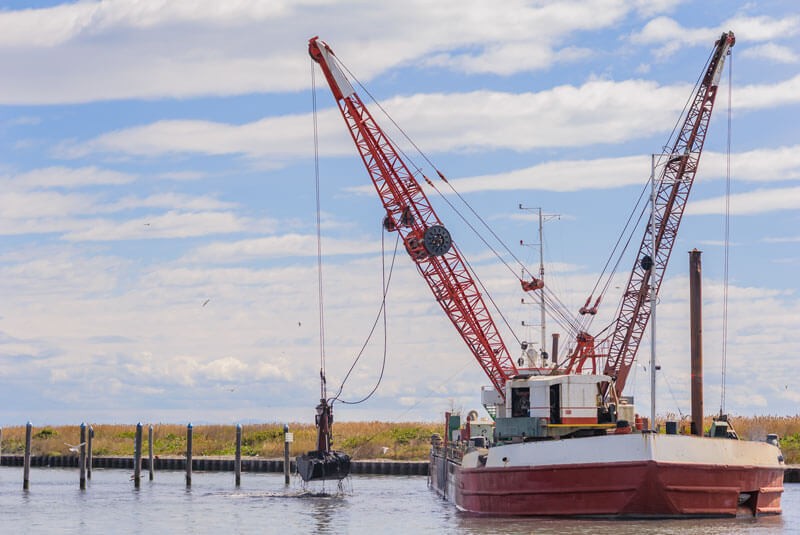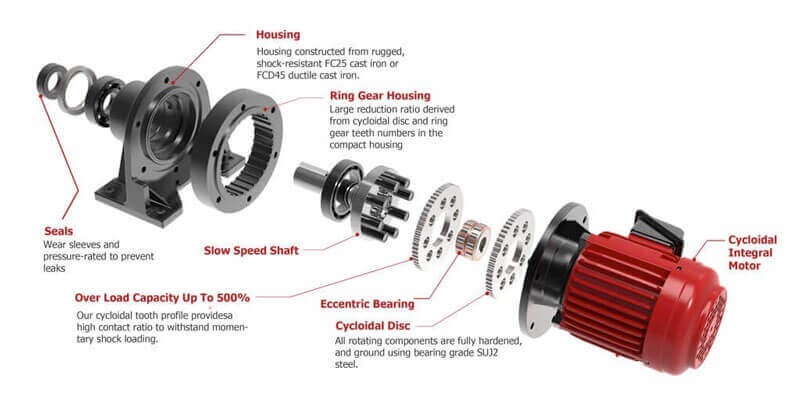Cycloidal Gearboxes For The Dredging Industry
Rugged reliability makes cycloidal gearboxes the perfect choice for efficient dredging operations in any environment
Reliable Cycloidal Gearboxes In The Dredging Industry
For dredging applications, the reliability of cycloidal gearboxes for lengthy continuous operation with predictable maintenance requirements is a significant benefit. Most dredging operations require drives that can survive repeated heavy shock loadings, and this is where cycloidal gearboxes come into their own.
Dredging environments are wet and contaminated with minerals. In salty sea water dredging operations it is vital that your drive can withstand this particularly hostile environment. Conventional drives require much more frequent maintenance in these conditions and are more likely to fail than cycloidal gearboxes.
Compact, easily sealed cycloidal gearboxes provide a flexible alternative to conventional drives and speed reducers that is perfect both for dredging-specific machinery and general transport and pumping tasks associated with fluid dredging.
How are cycloidal gearboxes used In the dredging industry?
There are ten major applications of cycloidal gearboxes in the dredging industry, these are:
- Dredges
- Cable Reels
- Conveyors
- Cutter Head Drives
- Jig Drives
- Maneuvering WInches
- Pumps
- Screen Drives
- Stackers
- Utility Winches
To meet the needs of these applications, Transcyko cycloidal gearboxes and cyclo derivatives make an excellent first choice, but can also be retrofitted as a cost-effective, reliable replacement for existing conventional drives, gearboxes, and reducers.
Cycloidal designs are robust & easy to maintain
Conventional gearboxes often fail under shock load because stresses are focused on single shafts and gears. Cycloidal gearboxes share the loads internally across multiple components, making them highly resistant to the type of shock loadings experienced in the dredging industry.
Cycloidal gearboxes very rarely fail without warning due to shock loading, and this means predictable and convenient maintenance intervals can be built into downtime in your schedule to suit the requirements of your dredging business without losing revenue.
Standardized cyclo drives enable you to save time & money
It is often possible to use a standard cyclo drive model for many different dredging applications, especially pumping systems, because they are compact and can be rated for very high torque and shock loading. This makes them a versatile hot-swap option for multiple applications, and a direct replacement option for cyclo drives from other manufacturers.
What are three benefits of using standardized cyclo drives instead of conventional drives?
1. Standardization enables drives to be swapped out rapidly for easy maintenance and repair without halting production.
2. Standardization reduces the number of different parts that need to be kept in stock for maintenance and servicing.
3. Fewer different sizes of reducers or gearboxes are needed
Cycloidal gearboxes are a cost effective option for the dredging industry
A shorter cycloidal gearbox can offer the same power and torque output as a significantly larger, and more costly conventional gearbox. This is because despite its compact size it can deliver better efficiency and higher power ratings than conventional gearboxes.
Cycloidal gearboxes can also be easily standardized for multiple applications across different types of commonly used machinery used in dredging operations. This simplifies and standardizes maintenance operations, reduces parts inventory, and increases efficiency.
Selecting A Cycloidal Gearbox For Dredging Industry Use
How do I select a cycloidal gearbox?
The selection of suitable cycloidal gearboxes depends on motor horsepower and/or torque requirements measured at the output shaft. Cycloidal gearboxes are extremely efficient over a wide range of reduction ratios. This usually means input power can be reduced, and a motor with a lower HP rating can be used, without losing output shaft torque.
What information do I need to select a cycloidal gearbox?
To identify the correct cycloidal gearbox for your needs, you will need to evaluate:
- The application: what type of machine is being driven
- Expected daily hours of operation
- Motor horsepower (HP) and speed (RPM)
- Mounting type: vertical, horizontal, right-angle…
Make a note of any specialized requirements including environmental exposure, as this will be useful in determining specific casing and construction details.
How are Service Classes used for cycloidal gearboxes & drives?
AGMA-defined Service Classes are used to rate cycloidal gearmotors for specific operational loading requirements. AGMA Service Classifications for gearmotors are: uniform (I), moderate shock (II), and heavy shock (III). These classifications enable you to fit your product selection to specific tasks.
In the dredging industry, cutter head drives, screen drives and jig drives are AGMA Service Class III, with high shock loadings and capable of operating continuously up to 24hrs a day. All other specialized requirements for dredging are AGMA Service Class II with moderate shock loadings for both 10hr and 24hr operational cycles when applicable.
Will a cycloidal gearbox withstand unexpected shock loads?
Cycloidal gearboxes, cyclo drives and cycle speed reducers are designed to be more shock resistant than planetary gearboxes, with loads evenly spread between moving parts. Cycloidal gearboxes will normally withstand momentary intermittent shocks of up to 500% of their standard rating.
Planetary gearboxes are normally only rated to a maximum momentary shock overload of 300%. Our technical team are ready to set up a custom configuration for you if you are expecting shock loads greater than 500% of the rating.
What are standard input speeds for cycloidal gearboxes?
Standard cycloidal gearbox speeds at 60Hz are 1750 and 1165 RPM. This equates to 1450 and 980 RPM at 50Hz. Our technical team are always happy to discuss any requirement, however, including the calculation of non-standard input speed effects on torque ratings and horsepower.
What are the thermal capacity limitations of cycloidal gearboxes?
Cycloidal gearboxes experience smooth, almost frictionless operation, which gives them a thermal rating beyond their mechanical capacity. Unlike traditional helical gears, the shared internal loadings of cycloidal gearboxes do not suffer from conventional heat limitations even in extreme and continuous operation.
What inverter turn-down ratio is available?
Unbraked motors have a standard 10:1 ratio. Depending on power rating, braked motors may be limited to 4:1 or better. A ratio of 1000:1 is available in a C-face configuration.
Key Features of Transcyko 600 Series Cycloidal Gearboxes
- Wear sleeves and pressure rated seals ensure excellent sealing of the cycloidal gearbox even in harsh conditions.
- Casings constructed of rugged, shock-resistant FC25 cast iron or FCD45 ductile cast iron.
- Reduction gearing is contained in a compact ring gear housing for high power density enabling large reduction ratios.
- Fail-safe service as stresses are shared across 60% of component parts during operation, compared to 5% or less for conventional drives.
- Rotating components are vacuum degassed, hardened bearing grade SUJ2 steel for consistent and reliable performance.
- Output shafts can be customized to any size or material requirement.
- Overload capacity withstands momentary shock loads of up to 500% of normal operational range.



